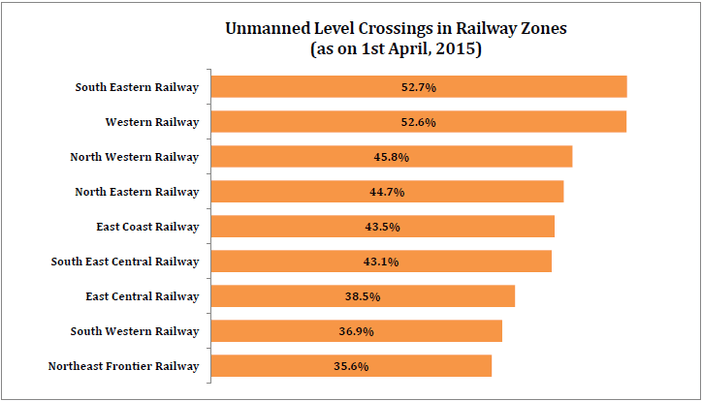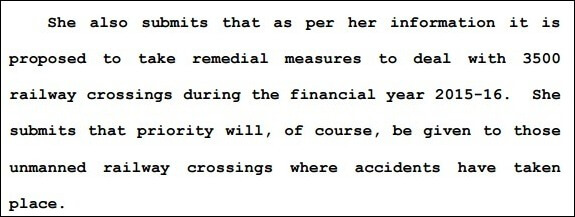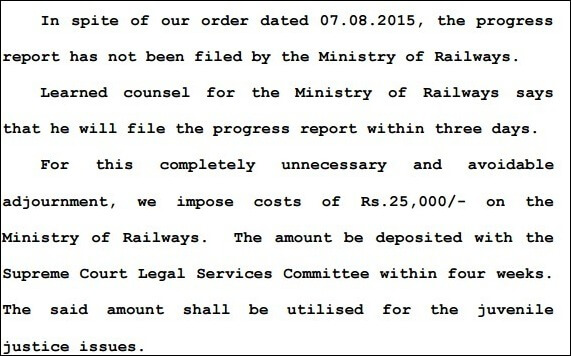[orc]Accidents at Railway Level Crossings have claimed many lives over the years. According to the latest data provided by the Ministry of Railways, more than 10000 level crossings in the country are still unmanned and only 156 of them were manned in the last six months.
The Supreme Court is currently hearing a PIL filed by one Mr. Ajay Gautam after 26 school children were killed in an accident at a Railway Level Crossing in Telangana in 2014. Accidents at unmanned railway level crossings (LCs) have claimed many lives over the years. While successive railway ministers have spoken about eliminating the unmanned railway crossings, not much progress is visible. According to data provided by the Ministry of Railways, more than 35% (more than 10000) of the railway level crossings are still unmanned.
More than a half of the Level Crossings are Unmanned in Western & South Eastern Zones
More than half of the level crossings are unmanned in South Eastern Railway headquartered at Kolkata and Western Railways headquartered at Mumbai. Of the 16 railway zones, more than 35% of the LCs are unmanned in each of the 9 zones. Less than 10% of the LCs are unmanned only in two of the 16 zones, West Central & Eastern Railway. The percentage of unmanned LCs is more than the national average in nine of the sixteen railway zones.
Of the 29487 level crossings across the country, 19047 are manned and 10440 are unmanned. More than half of the unmanned LCs are from the four zones; Western, North Western, Northern & North Eastern. Western Railways has 2087 unmanned LCs and the three other zones have more than 1000 unmanned LCs. Only two zones (Eastern & West Central) have less than 100 unmanned LCs.

15 accidents in 6 months
In the six month period from August 2015 to January 2016, a total of 15 accidents occurred at level crossings across eight different zones. 26 people were killed and 15 were injured in these accidents. Four of these accidents were in the Northern Zone while both North Eastern & North Western Zones accounted for three accidents each. These three zones accounted for 2/3rd of all the accidents and all these three zones have more than 1000 unmanned level crossings.
Only 156 Level Crossings manned in Six months
In the six month period from August 2015 to January 2016, only 156 unmanned level crossings were manned across 11 zones. Of these 156, 38 LCs were from East Coast & 30 from South Western. At this rate, it will take more than 30 years to man all the unmanned level crossings.
An Empty Promise?
Despite assurances to the Supreme Court, the Railways seem to have done very little to address this issue. In Feb, 2015 the counsel for the Railways told the Supreme Court that remedial measures will be taken up at 3500 railway crossings during 2015-16. But the current data indicates that this promise was not kept.

In fact, the Supreme Court has recently imposed a cost of Rs 25,000 on the Ministry of Railways for failing to file the progress report about the status of unmanned railway crossings. One only hopes that this year’s budget goes beyond the empty promise.

Featured Image: sixtybolts | Flickr



2 Comments
Great Article with well researched facts !. I propose a very simple yet cost effective solution to start with using technology available
Indian Railways has an API which gives you real time location of any train. At Each unmanned location we put this basic phone connected to a
loud speaker / lights etc , this device which will blare out a loud alarm /flash lights when a train is nearby like (100ft ) of the unmanned
crossing. The device can sound the alarm based on a sms message which it gets from a server which continously monitor the real time locations
of all the trains and know which phone to send the sms based on the location.
The whole phone / alarm/ device can be sponsored by private companies near the unmanned crossing. This way atleast somebody who is
trying to cross an unmanned crossing , they will hear the alarm sound or see flashing lights when train is very close.
I do hope some thought is giving to the above solution as lot of lives are lost every year. What good is all the technologies we have at our
disposal when we can’t bring it together to save lives. !
as usual, thanks